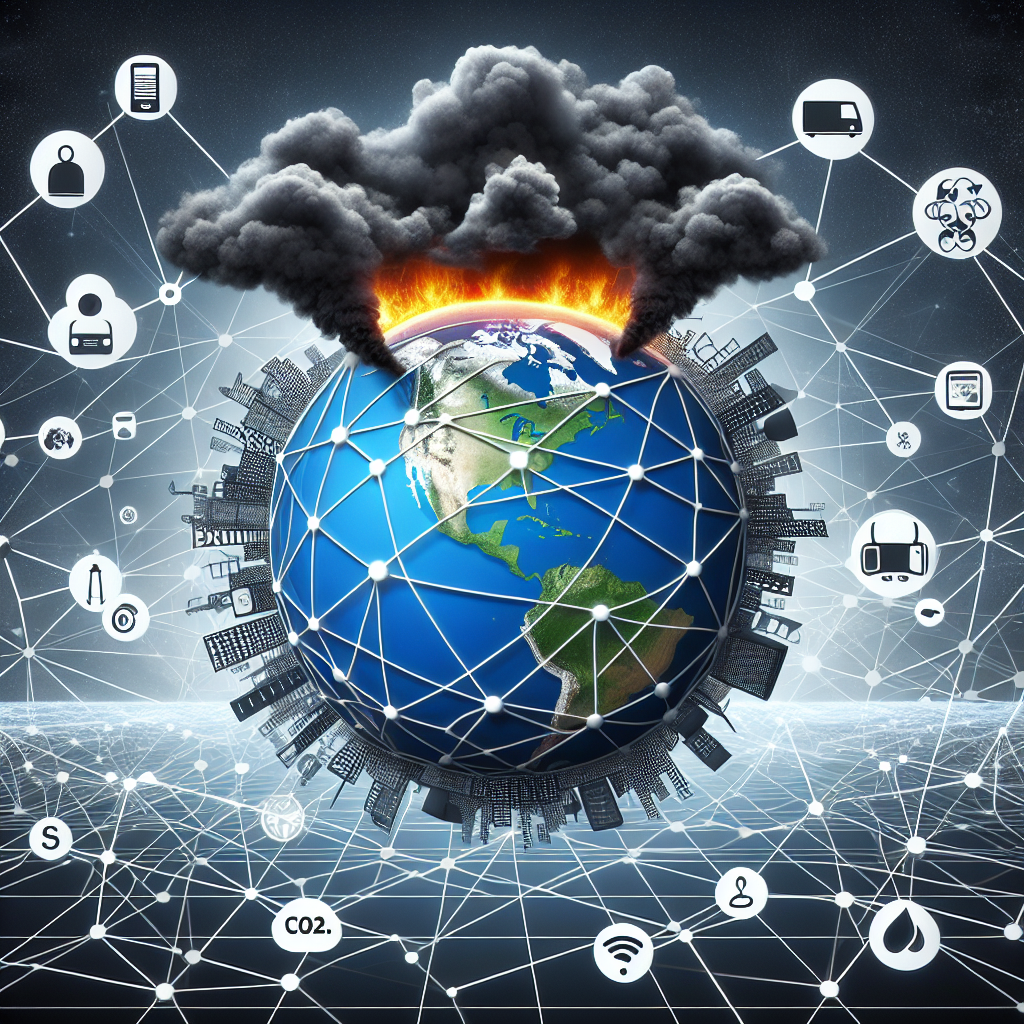The internet has undoubtedly revolutionized the way we live, work, and communicate. However, the convenience and connectivity that it brings also come with a significant environmental cost. The impact of internet data usage on climate change is a pressing issue that demands our attention. From streaming videos to sending emails, every online activity consumes energy and contributes to carbon emissions. As our digital footprint grows, so does the strain on our planet. Understanding the connection between internet data usage and climate change is crucial in order to make informed decisions about our online behavior and its impact on the environment. Let’s explore how our online habits are shaping the future of our world.
Understanding the Basics of Internet Data Usage

Internet data usage refers to the amount of data transmitted and received by users browsing the internet. It encompasses the various activities individuals engage in while online, such as streaming videos, downloading files, sending emails, and browsing websites. The data consumed during these activities is processed and stored in data centers and servers, which play a critical role in facilitating internet connectivity and access.
Definition of Internet Data Usage
Internet data usage can be defined as the volume of digital information exchanged between users and online platforms. This data is measured in bytes, kilobytes, megabytes, gigabytes, and terabytes, depending on the quantity of information transmitted. The more data a user consumes while engaging in online activities, the higher their internet data usage.
Types of Activities that Contribute to Internet Data Usage
- Streaming Media: Watching videos on platforms like YouTube, Netflix, and Hulu consumes significant amounts of data due to the continuous transmission of audiovisual content.
- Downloading Files: Retrieving files from the internet, such as documents, images, and software, contributes to data usage as the files are transferred to the user’s device.
- Online Gaming: Multiplayer online games require a constant exchange of data between players and servers, leading to high data usage.
- Social Media Interaction: Engaging with social media platforms involves loading images, videos, and posts, increasing the data consumed during browsing.
- Cloud Storage: Uploading and downloading files to and from cloud storage services like Google Drive and Dropbox adds to internet data usage.
Importance of Data Centers and Servers
Data centers and servers are essential infrastructure components that store, process, and distribute internet data. They serve as the backbone of the digital ecosystem, enabling the seamless transfer of information across networks. Data centers require significant energy to operate efficiently, leading to environmental implications such as increased carbon emissions and energy consumption. The location and design of data centers can impact climate change due to their energy requirements and cooling systems.

The Link Between Internet Data Usage and Carbon Emissions
- Exploring the energy consumption of data centers
Data centers are the backbone of the digital world, requiring massive amounts of electricity to power and cool the servers storing and processing online information. The energy consumption of data centers is a significant contributor to carbon emissions, with estimates suggesting that these facilities account for about 1% of global electricity demand. The continuous operation of servers and networking equipment results in a continuous need for power, much of which comes from non-renewable sources like coal and natural gas, further exacerbating the carbon footprint.
- Impact of data transmission on carbon footprint
Every time data is transferred over the internet, whether it’s streaming a video, sending an email, or browsing a website, energy is consumed. This energy consumption comes from the data centers, network infrastructure, and end-user devices involved in the data transmission process. The carbon footprint of data transmission is influenced by factors such as the distance data travels, the efficiency of the network infrastructure, and the energy sources powering the data centers. As internet usage continues to grow globally, so does the carbon footprint associated with data transmission.
- Carbon footprint comparison: Internet data usage vs. other industries
When comparing the carbon footprint of internet data usage to other industries, it becomes evident that the digital economy has a substantial environmental impact. While data centers and data transmission contribute significantly to carbon emissions, other industries like transportation and manufacturing have historically been the focus of climate change mitigation efforts. However, as internet usage becomes more pervasive and data-intensive applications become the norm, the carbon footprint of the digital sector is increasingly coming under scrutiny. Efforts to reduce the environmental impact of internet data usage are crucial in the broader context of addressing climate change.
Understanding the basics of internet data usage and its impact on climate change is essential in recognizing the environmental implications of our digital activities. From streaming media to online gaming, every online interaction contributes to data transmission and energy consumption. By taking individual actions to monitor data usage, optimize streaming quality, and use Wi-Fi when possible, we can collectively work towards reducing the environmental footprint of internet data usage. Additionally, advancements in green data center technologies and the integration of artificial intelligence offer promising solutions to improve energy efficiency and minimize carbon emissions in data management. Collaborative efforts between industry stakeholders, policymakers, and individuals are crucial in creating a sustainable internet infrastructure that mitigates its contribution to climate change.
Energy Efficiency Measures in Data Centers
Data centers play a crucial role in the internet infrastructure, but they also consume vast amounts of energy, contributing to carbon emissions and climate change. To address this issue, various energy efficiency measures have been implemented in data centers to reduce their environmental impact.
-
Implementing renewable energy sources: One key strategy to improve the energy efficiency of data centers is to transition to renewable energy sources such as solar, wind, or hydroelectric power. By generating electricity from renewable sources, data centers can significantly reduce their carbon footprint and reliance on fossil fuels.
-
Cooling systems and energy consumption: Data centers require substantial cooling systems to prevent overheating of servers and equipment. Implementing energy-efficient cooling technologies, such as free cooling or liquid cooling solutions, can help reduce overall energy consumption and improve the sustainability of data center operations.
-
The role of data center location in energy efficiency: The location of a data center can also impact its energy efficiency. Building data centers in regions with access to renewable energy sources or cooler climates can lower energy costs and decrease carbon emissions. Additionally, proximity to major internet hubs can reduce latency and improve overall network performance, further optimizing energy usage.
Mitigating Carbon Emissions from Data Transmission
he Link Between Internet Data Usage and Carbon Emissions
- The Concept of Data Routing and Its Environmental Impact
Data routing plays a crucial role in determining the carbon footprint of internet data usage. When data is transmitted over the internet, it often takes multiple routes through various servers and networks before reaching its final destination. Each additional hop in the data transmission process consumes energy, leading to increased carbon emissions. Therefore, optimizing data routing is essential to minimize the environmental impact of data transmission.
-
Strategies to Reduce Data Transmission Energy Consumption
-
Data Compression: Implementing data compression techniques can significantly reduce the size of files being transmitted, thereby lowering the amount of data that needs to be sent over the network. This reduction in data volume directly translates to energy savings and decreased carbon emissions.
-
Caching and Content Delivery Networks (CDNs): Utilizing caching mechanisms and CDNs can help store frequently accessed data closer to end-users, reducing the distance data needs to travel and decreasing the energy required for transmission. By minimizing the distance data travels, CDNs contribute to lower carbon emissions associated with data transmission.
-
Efficient Protocols and Algorithms: Employing efficient data transmission protocols and algorithms can improve network performance and reduce energy consumption. By optimizing the way data is transmitted, unnecessary energy expenditures can be minimized, resulting in a more environmentally sustainable data transmission process.
-
Importance of Optimizing Data Delivery Routes

Optimizing data delivery routes is critical for mitigating carbon emissions from data transmission. By selecting the most energy-efficient paths for data to travel, unnecessary energy consumption can be avoided. Additionally, optimizing data delivery routes can help reduce latency and improve overall network performance, leading to a more sustainable and environmentally friendly internet infrastructure.
Policy and Industry Initiatives Addressing Climate Impact
Government regulations on data centers’ energy consumption
- Governments worldwide are implementing regulations to address the energy consumption of data centers, which are significant contributors to carbon emissions.
- These regulations aim to enforce energy efficiency standards, promote the use of renewable energy sources, and incentivize data centers to reduce their carbon footprint.
- By imposing limits on energy consumption and carbon emissions, governments are pushing data centers to adopt more sustainable practices and technologies to mitigate their environmental impact.
Industry standards and certifications for sustainable data centers
- Industry organizations have developed standards and certifications specifically focused on promoting sustainability in data centers.
- These standards outline best practices for energy efficiency, waste reduction, and carbon offsetting within data centers to ensure they operate in an environmentally responsible manner.
- By adhering to these certifications, data centers can demonstrate their commitment to reducing their climate impact and differentiate themselves as leaders in sustainable data management.
Collaborative efforts to reduce the carbon footprint of internet data usage
- Various stakeholders, including tech companies, environmental organizations, and policymakers, are engaging in collaborative efforts to address the carbon footprint of internet data usage.
- Initiatives such as carbon offset programs, renewable energy partnerships, and data sharing for energy efficiency optimization are being pursued to collectively reduce the environmental impact of digital activities.
- Through collaboration and shared responsibility, the goal is to create a more sustainable internet infrastructure that minimizes its contribution to climate change.
Individual Actions to Reduce Environmental Impact
In today’s digital age, where internet data usage is at an all-time high, it is crucial for individuals to take proactive steps to reduce their environmental impact. By making conscious choices and adopting sustainable practices, we can collectively work towards mitigating the effects of climate change. Here are some practical tips for minimizing personal internet data consumption:
-
Monitor Data Usage: Keep track of your data usage across devices to identify areas where you can cut back on unnecessary consumption. Set data limits on your devices and regularly review your usage patterns.
-
Optimize Streaming Quality: Streaming services account for a significant portion of internet data consumption. Consider lowering the streaming quality on platforms like Netflix and YouTube to reduce the amount of data being transmitted.
-
Disable Auto-Play Features: Auto-play features on social media platforms and websites can lead to continuous data streaming without active engagement. Disable these features to control your data usage.
-
Use Wi-Fi Whenever Possible: Opt for Wi-Fi connections over mobile data whenever feasible. Wi-Fi networks are generally more energy-efficient than mobile data networks, especially when streaming or downloading large files.
-
Unsubscribe from Unnecessary Emails: Emails with large attachments or multimedia content can contribute to data consumption. Unsubscribe from mailing lists and promotional emails to reduce unnecessary data usage.
By implementing these simple yet effective strategies, individuals can play a significant role in minimizing their environmental footprint associated with internet data usage. Making informed choices and embracing sustainable practices can contribute to a greener and more sustainable digital future.
Future Trends and Innovations in Sustainable Data Management
In the realm of sustainable data management, advancements in technology play a pivotal role in mitigating the environmental impact of internet data usage. The following trends and innovations are shaping the future of sustainable data management:
Advancements in Green Data Center Technologies
- Renewable Energy Integration: Green data centers are increasingly incorporating renewable energy sources such as solar and wind power to reduce reliance on fossil fuels.
- Liquid Cooling Systems: Emerging technologies like liquid cooling systems are being adopted to improve energy efficiency and reduce the carbon footprint of data centers.
- Energy-Efficient Hardware: Manufacturers are developing energy-efficient servers and networking equipment to minimize electricity consumption and heat generation in data centers.
The Potential of Artificial Intelligence in Optimizing Energy Efficiency
- Predictive Analytics: AI algorithms are being used to analyze data patterns and predict demand fluctuations, enabling data centers to optimize energy usage based on real-time requirements.
- Dynamic Resource Allocation: AI-powered systems can dynamically allocate resources based on workload demands, ensuring efficient utilization of energy and reducing wastage.
- Smart Cooling Systems: AI-driven cooling systems can adjust temperatures in data centers based on workload intensity, leading to significant energy savings and lower carbon emissions.
Collective Efforts Towards a Greener Digital Future
- Industry Collaboration: Stakeholders in the tech industry are collaborating to develop sustainability standards and best practices for data management, fostering a collective commitment to reducing environmental impact.
- Policy Initiatives: Governments worldwide are implementing regulations and incentives to promote energy efficiency in data centers, driving the adoption of sustainable practices across the industry.
- Public Awareness Campaigns: Educational initiatives and awareness campaigns are raising public consciousness about the environmental consequences of internet data usage, encouraging individuals and organizations to make greener choices in data management.
FAQs: The Impact of Internet Data Usage on Climate Change
What is the connection between Internet data usage and climate change?
The increasing demand for streaming services, cloud storage, and online activities has led to a significant rise in data consumption. This results in a higher demand for energy in data centers, which are often powered by fossil fuels. The production and maintenance of data centers contribute to carbon emissions, which in turn accelerate climate change.
How does Internet data usage contribute to greenhouse gas emissions?
Data centers rely on electricity to operate and cool their servers, which often comes from burning coal, natural gas, or other fossil fuels. The energy consumption of data centers is a major contributor to greenhouse gas emissions, as these sources release CO2 and other harmful gases into the atmosphere. Additionally, the manufacturing and disposal of electronic devices used for Internet connectivity also have environmental impacts.
Are there any ways to lessen the environmental impact of Internet data usage?
There are a few steps that can be taken to reduce the environmental impact of Internet data usage. This includes optimizing data centers for energy efficiency, transitioning to renewable energy sources, and promoting data center consolidation to reduce overall energy consumption. Individuals can also do their part by minimizing unnecessary data usage, turning off devices when not in use, and supporting companies that prioritize sustainability in their operations.
What are some long-term solutions to address the impact of Internet data usage on climate change?
Governments, businesses, and individuals must work together to address the environmental impact of Internet data usage. This includes implementing policies and regulations that promote energy efficiency in data centers, investing in renewable energy sources, and promoting sustainable practices in the tech industry. Additionally, increasing awareness about the connection between data consumption and climate change can help drive further action towards reducing carbon emissions.